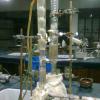I am working on retrofitting an very old designed crude column (1980's). In this column, there are 4 side draws but only 2 PA's.
Ajay,
if you add a new PA to an existing crude column you will lose fractionation sharpness above that new PA.
First of all the new PA will require several trays for heat transfer that go at the expense of present fractionation trays.
Secondly due to the new PA there will be less vapor liquid traffic in the column section above the new PA.
So fractionation sharpness is reduced in the whole column above the new PA due to less equilibrium stages as well as less reflux from the top.
Increasing duties of existing PA's will also result in less separation sharpness above their location due to less vapor liquid traffic as a result of less reflux from the top.
You would need to cut the column and insert a new column part with additional new trays to make it feasible to add a new PA. If that is not what the owner wants then there is not much you can do but minor finetuning of the column operation.
Edited by PingPong, 18 November 2017 - 04:11 AM.

 FB
FB












